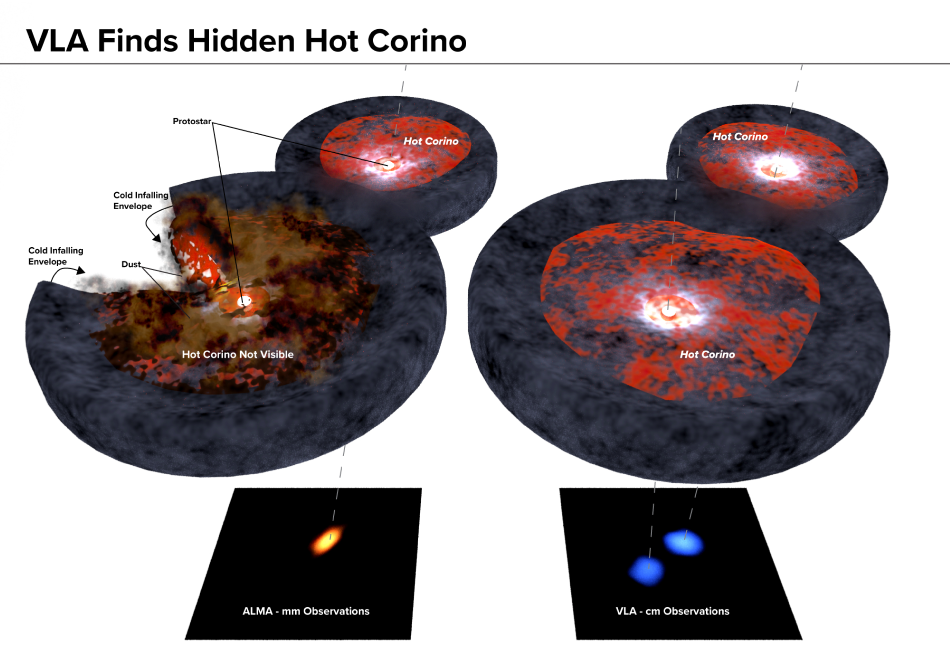Jun 9 2020
In response to an intuition, a group of astronomers has presumably solved a puzzle related to young, still-forming stars and organic molecules-rich regions closely surrounding them.
 When a pair of young protostars called IRAS 4A was observed at millimeter wavelengths, left, the “hot corino” of complex organic molecules surrounding one of the stars was obscured by dust. Observations with the VLA at longer wavelengths that pass through dust revealed the dust-enshrouded hot corino. Image Credit: Bill Saxton, NRAO/AUI/NSF.
When a pair of young protostars called IRAS 4A was observed at millimeter wavelengths, left, the “hot corino” of complex organic molecules surrounding one of the stars was obscured by dust. Observations with the VLA at longer wavelengths that pass through dust revealed the dust-enshrouded hot corino. Image Credit: Bill Saxton, NRAO/AUI/NSF.
The National Science Foundation’s Karl G. Jansky Very Large Array (VLA) was used to unravel one such region that had earlier evaded detection. The new finding has offered a solution to a longstanding question.
Complex organic molecules found in the regions around the young protostars can further combine into prebiotic molecules, which are the initial stages on the path to life. Named “hot corinos” by astronomers, the regions are usually about the size of the Solar System and are considerably warmer compared to their surroundings. Yet, by terrestrial standards, they are still very cold.
Discovered first in 2003, only about a dozen hot corinos have been identified to date. A majority of these are in binary systems, with two protostars forming at the same time.
A bewildering fact for the astronomers is that, in certain binary systems, evidence for a hot corino was found around one of the protostars but not the other.
Since the two stars are forming from the same molecular cloud and at the same time, it seemed strange that one would be surrounded by a dense region of complex organic molecules, and the other wouldn’t.
Cecilia Ceccarelli, Institute for Planetary Sciences and Astrophysics, University of Grenoble
Through the detection of particular radio frequencies, or spectral lines, discharged by the molecules, researchers were able to find the complex organic molecules. Such characteristic radio frequencies are useful as “fingerprints” to find the chemicals.
According to the astronomers, all the chemicals contained in hot corinos had been identified through the detection of these “fingerprints” at radio frequencies in line with the wavelengths of only a few millimeters.
We know that dust blocks those wavelengths, so we decided to look for evidence of these chemicals at longer wavelengths that can easily pass through dust. It struck us that dust might be what was preventing us from detecting the molecules in one of the twin protostars.
Claire Chandler, Principal Investigator of the Project, National Radio Astronomy Observatory
The VLA was used to observe a pair of protostars known as IRAS 4A, in a star-forming region located nearly 1,000 light-years from Earth. The pair was observed at wavelengths of the order of centimeters. At such wavelengths, they searched for radio emissions from methanol, CH3OH (wood alcohol, not for drinking). As observed using the much shorter wavelengths, in this pair, one protostar evidently had a hot corino and the other did not.
The study outcomes confirmed the intuition of the astronomers.
“With the VLA, both protostars showed strong evidence of methanol surrounding them. This means that both protostars have hot corinos, and the reason we didn’t see the one at shorter wavelengths was because of dust,” stated Marta de Simone, a graduate student at IPAG who headed the data analysis for this object.
The astronomers warn that although both the hot corinos are now known to have methanol, there still could be certain chemical differences between them. According to them, these differences can be resolved by seeking other molecules at wavelengths not hidden by dust.
This result tells us that using centimeter radio wavelengths is necessary to properly study hot corinos. In the future, planned new telescopes such as the next-generation VLA and SKA, will be very important to understanding these objects.
Claudio Codella, Arcetri Astrophysical Observatory, Florence, Italy
Journal Reference:
De Simone, M., et al. (2020) Hot Corinos Chemical Diversity: Myth or Reality? The Astrophysical Journal Letters. doi.org/10.3847/2041-8213/ab8d41.